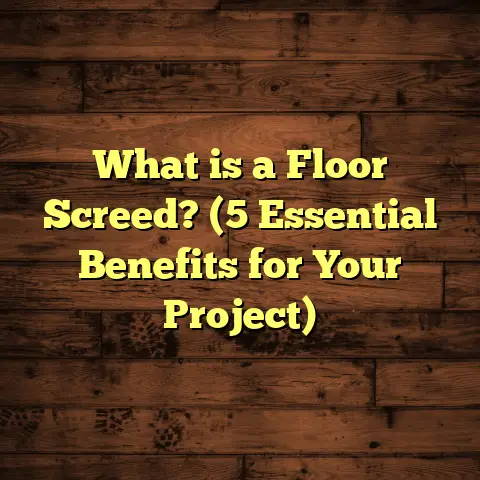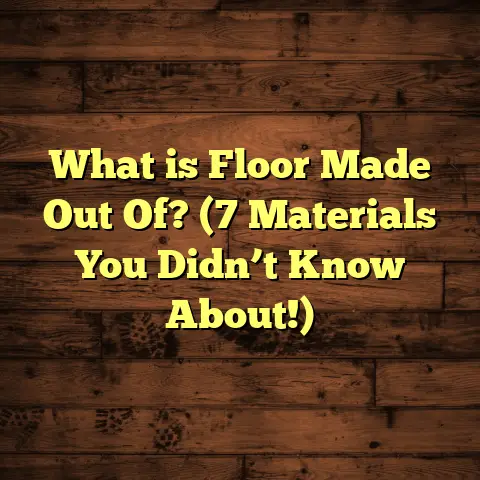What is Vertical Displacement in Floors or Foundations? (5 Key Impacts Revealed)
Timeless structures are the foundation of every home, yet beneath the surface, subtle shifts can quietly change everything. I’ve been in the flooring and foundation business for years, and one thing I’ve seen repeatedly is how vertical displacement can affect floors and foundations. It’s something that doesn’t always grab attention right away, but its impacts can be quite serious.
Let me walk you through what vertical displacement actually means and why it matters so much to anyone who cares about the stability and longevity of their home.
What is Vertical Displacement in Floors or Foundations?
Vertical displacement refers to the upward or downward movement of a portion of a building’s floor or foundation relative to another part. Imagine a slab of concrete or a wooden floor that’s no longer level because one section has shifted vertically. This movement can be tiny—sometimes just a few millimeters—but even small shifts can cause cracks, uneven surfaces, or structural issues over time.
This happens due to several factors like soil movement beneath the foundation, water damage, poor construction practices, or natural settling of the building over time. The key point is that vertical displacement creates a difference in height between two points on the floor or foundation where there used to be none.
I’ve encountered this issue on many projects, from small residential homes to larger commercial buildings. Sometimes it’s a minor inconvenience, but other times it signals deeper problems that need urgent attention.
How I Recognized Vertical Displacement Early On
Years ago, I was called to inspect an old house where the owner complained about uneven floors and doors that wouldn’t close properly. Walking through the space, I noticed a visible dip near the living room wall. Using a laser level and measuring tools, I confirmed there was about a 1.5-inch drop over just a few feet—classic vertical displacement.
The root cause? The soil beneath that section had compacted unevenly due to poor drainage and heavy rain seasons, causing the foundation to settle unevenly. At first glance, it seemed like just a floor repair job, but it turned out to be a foundation stabilization project.
This situation taught me how crucial it is to correctly diagnose vertical displacement early before it leads to bigger headaches.
5 Key Impacts of Vertical Displacement in Floors or Foundations
When vertical displacement occurs, it doesn’t just affect how your floor looks or feels underfoot; it can have deeper consequences. Here’s what I’ve learned about the five main impacts you might face:
1. Uneven Floors and Trip Hazards
One of the most obvious signs is an uneven floor surface. Walking across a room where one part is higher or lower than the rest often feels strange. This isn’t just annoying—it can become dangerous.
In my experience, floors with vertical displacement exceeding 1/4 inch over 6 feet pose an increased risk of tripping injuries. According to the Consumer Product Safety Commission, falls related to uneven flooring contribute to thousands of emergency visits each year.
If you notice slight bumps or dips that grow over time, don’t ignore them. I’ve seen homes where small unevenness developed into major trip hazards within months.
2. Cracking in Walls and Floors
When parts of your foundation move vertically, the stresses don’t stay isolated. They transfer to walls, floors, and even ceilings. Cracks often appear near doors or windows where framing meets displaced flooring.
In one renovation project, a homeowner reported hairline cracks around baseboards and drywall corners. After investigation, we linked these cracks directly to a 2-inch vertical displacement in one corner of their foundation caused by soil erosion.
Structural engineers recommend repairing displacement over 1 inch quickly because cracks tend to widen and multiply if left untreated. It’s not just cosmetic damage—it affects structural integrity.
3. Doors and Windows That Don’t Close Properly
Have you ever struggled with a door that suddenly sticks or jams? Often, this is connected to shifts in the underlying structure.
Vertical displacement changes the alignment of door frames and window sills. Even minor shifts—say 1/8 inch—can make doors scrape floors or windows fail to latch securely.
It’s something I warn clients about early because fixing misaligned doors often requires addressing the root cause: foundation movement, not just door adjustments.
4. Water Intrusion and Drainage Problems
Vertical displacement can alter how water flows around your home’s foundation. If one side sinks lower, water may pool against walls instead of draining away.
From my observations on numerous sites, homes with uneven foundations face increased risk of basement flooding or moisture intrusion. This leads to mold growth, wood rot, and other expensive repairs.
The National Association of Waterproofing & Structural Repair reports that water-related foundation issues cause nearly 50% of all basement repairs annually. Fixing displacement early helps prevent these costly outcomes.
5. Reduced Property Value and Increased Repair Costs
Finally, vertical displacement has financial impacts. Buyers often shy away from homes with uneven floors or visible foundation problems unless priced accordingly.
In my years working with real estate agents and homeowners, I’ve seen properties lose 10-30% value due to unresolved foundation issues. Worse yet, delaying repairs only raises costs as damage spreads.
Early detection and remediation usually cost less than full-scale reconstruction later on. A study by HomeAdvisor found foundation repairs average around $4,000-$10,000 nationally but can skyrocket depending on severity.
Challenges I’ve Faced Dealing With Vertical Displacement
It’s not always easy to diagnose or fix vertical displacement problems quickly. Here are some challenges I’ve come across:
- Hidden Issues: Sometimes floors look fine on the surface but have underlying displacement affecting stability.
- Complex Soil Conditions: Clay soils expand and contract drastically with moisture changes, making it tough to predict movements.
- Cost vs Priority: Homeowners may hesitate to invest in foundation fixes until visible damage worsens.
- Matching Materials: Repairing floors after leveling foundations requires careful selection to blend old and new flooring.
- Access Problems: Older homes with crawl spaces or basements pose logistical challenges for underpinning or stabilization work.
Despite these hurdles, every project taught me more about diagnosing subtle signs early and designing effective solutions.
Success Stories & Data-Backed Insights
Let me share two examples from my experience that highlight positive outcomes when vertical displacement is handled properly:
Case Study 1: Residential Foundation Stabilization
A couple called me after noticing sloping floors in their living room (about 2 inches difference). I performed soil tests and found high clay content with poor drainage causing seasonal shifts.
We installed helical piers to stabilize the foundation and re-leveled the floor using self-leveling compounds beneath engineered hardwood flooring. Follow-up inspections showed no further displacement after two years.
Their home value increased by roughly 15% post-repair according to local real estate reports.
Case Study 2: Commercial Warehouse Floor Re-Leveling
A warehouse had significant vertical displacement due to poor compaction under concrete slabs during construction. This led to forklift accidents on uneven floors.
Using ground-penetrating radar and laser levelling technology, we identified problem zones and injected polyurethane foam beneath slabs for lifting.
The result was an immediate return to safe operations with zero accidents reported over 18 months following repairs.
How To Spot Vertical Displacement Early: My Tips for Homeowners
You might wonder how you can tell if your floors or foundation are moving vertically before things get worse. Here are some simple checks I suggest:
- Use a level tool or even a smartphone app with a bubble level feature.
- Check door/window operation regularly for sticking.
- Look for new cracks in walls near floors.
- Monitor water pooling near your foundation after rain.
- Pay attention if floors start feeling “bouncy” or uneven underfoot.
If any of these signs pop up, getting a professional inspection sooner rather than later can save you thousands down the road.
What Causes Vertical Displacement? Some Data You Should Know
Understanding causes helps prevent problems from starting:
| Cause | Impact on Vertical Displacement | Notes |
|---|---|---|
| Soil Settlement | Can cause up to several inches of drop | Clay soils worst due to shrink/swell cycles |
| Water Damage | Leads to soil erosion and instability | Poor drainage increases risk |
| Poor Construction | Inadequate compaction or design flaws | Common in older homes |
| Tree Roots | Can lift slabs causing upward displacement | Roots exert pressure on foundations |
| Freeze-Thaw Cycles | Soil expansion/contraction moves slabs | Especially in colder climates |
According to the U.S. Geological Survey, soil settlement causes nearly 60% of residential foundation problems nationwide.
How I Approach Repairing Vertical Displacement
Every case is unique but here’s my general method:
- Assessment: Thorough site inspection including laser levels and soil testing.
- Diagnosis: Pinpointing causes like drainage issues or soil type.
- Plan: Designing stabilization (piers, underpinning) or slab lifting.
- Execution: Using specialized equipment for minimal disruption.
- Follow-up: Monitoring for future movement and advising clients on maintenance.
This approach has helped me maintain long-term client satisfaction and reduced callbacks significantly.
The Science Behind Vertical Displacement: Soil Behavior Explained
Understanding why vertical displacement happens means understanding soil behavior under buildings. Soil isn’t just dirt; it has layers, moisture content, and physical properties that change over time.
For instance:
- Expansive clay soils swell when wet and shrink when dry — this constant movement causes foundations resting on them to shift vertically.
- Loose fill soils may settle under heavy weight until fully compacted.
- Organic soils degrade over time leading to subsidence (sinking).
I often collaborate with geotechnical engineers who provide detailed soil reports before we plan repairs. These reports include data like:
- Soil bearing capacity
- Moisture content fluctuations
- Compaction levels
Knowing this data helps me recommend solutions tailored for each site’s conditions rather than guessing what might work.
Tools & Technology That Help Me Detect Vertical Displacement Accurately
Back in the day, detecting vertical shifts was mostly guesswork based on visible signs like cracks or sloping floors. Now technology has improved dramatically:
- Laser Levels & Digital Inclinometers: Provide precise measurements within millimeters.
- Ground-Penetrating Radar (GPR): Reveals voids or unstable soil beneath slabs.
- Moisture Meters: Detect areas prone to water infiltration which could lead to soil problems.
- 3D Scanners: Map building surfaces for detailed analysis over time.
Using these tools early in inspections helps me catch problems before they get serious—saving clients money and stress.
Personal Story: When Vertical Displacement Nearly Cost Me a Client
I remember working on a historical home renovation where vertical displacement was suspected but not confirmed initially. The client wanted new hardwood flooring installed quickly without addressing underlying issues first.
After insisting on a thorough inspection using laser levels, we discovered nearly 2 inches of vertical displacement in one area caused by old drainage pipes leaking underground for years.
The client was upset about the delay but agreed when I explained how ignoring this could ruin new flooring within months. We fixed the foundation first—then installed flooring—and two years later they’re still thrilled with their stable floors.
This taught me that patience and thoroughness pay off more than rushing projects for quick wins.
Repair Methods Explained: What Works Best for Different Situations?
Depending on severity and cause, repair methods vary widely:
Underpinning with Piers
This involves driving steel piers deep into stable soil layers below unstable soil to support the foundation from beneath.
- Best for significant settlement (over 1 inch)
- Provides long-term stability
- Can be done with minimal disruption inside homes
Slab Jacking (Mudjacking)
A slurry mixture is pumped under sunken concrete slabs raising them back into position.
- Suitable for minor displacement up to a few inches
- Cost-effective but may not last as long as piers
- Can be messy during application
Polyurethane Foam Injection
High-density foam is injected under slabs causing them to lift as foam expands.
- Clean and fast
- Lightweight material reduces future settling
- Used increasingly in commercial settings
Soil Stabilization & Drainage Improvements
Fixing drainage around foundations reduces water pooling that causes soil erosion leading to displacement.
- French drains
- Grading corrections
- Gutter extensions
Often these measures are needed alongside structural repairs for lasting results.
Maintenance Tips After Repair: Keeping Your Floors Level Longer
Once repairs are done, maintenance becomes key:
- Inspect gutters yearly and keep them clear.
- Avoid planting large trees too close to your house.
- Monitor basement moisture levels with dehumidifiers if needed.
- Schedule periodic inspections every few years.
I always tell clients that foundation care is ongoing—just like maintaining your roof or HVAC system—to avoid surprises down the line.
Industry Data & Trends: What Current Studies Show About Floor Displacement Issues
Recent studies highlight how widespread vertical displacement issues are:
- The American Housing Survey estimates about 15% of U.S homes report some form of foundation problems linked to soil movement.
- According to Foundation Performance Association data, homes built on expansive clay soils show twice as many vertical displacement cases compared to sandy soils.
- Repair costs have risen by about 20% over five years due to labor shortages and advanced materials used in stabilization systems.
These trends underscore why early detection remains critical both for homeowners’ safety and budgets.
FAQ: Your Questions About Vertical Displacement Answered
Q: Can vertical displacement happen suddenly?
A: Usually it’s gradual over months or years as soil shifts slowly—but heavy rains or excavation nearby can cause sudden moves.
Q: Is vertical displacement covered by home insurance?
A: Often not unless caused by specific events like earthquakes; normal settling usually isn’t covered.
Q: Can I fix vertical displacement myself?
A: DIY isn’t recommended because improper fixes can worsen damage; professional diagnosis ensures correct treatment.
Q: How long does repair take?
A: Depends on method; small slab jacking jobs may take a day while underpinning can extend over weeks including preparation time.
Q: Will fixing displacement stop future movement?
A: Repairs stabilize current problems but ongoing soil conditions mean periodic monitoring is wise.
Wrapping Up My Thoughts on Vertical Displacement
Looking back over my years dealing with floors and foundations, vertical displacement stands out as a challenge that demands respect—not something you want catching you off guard. It’s easy for homeowners to overlook subtle signs until they become costly problems.
I’ve learned that paying attention early—whether through simple leveling checks or professional inspections—makes all the difference between manageable fixes today versus expensive disasters tomorrow.
So next time you walk across your floor, ask yourself: “Is everything feeling steady?” If not, don’t wait too long before taking action. Your home’s safety depends on it—and so does your peace of mind.
If you want help figuring out if your floors are shifting or need advice on repairs, just ask me—I’m always happy to share what I know from years in the field helping people keep their homes solid and secure.





